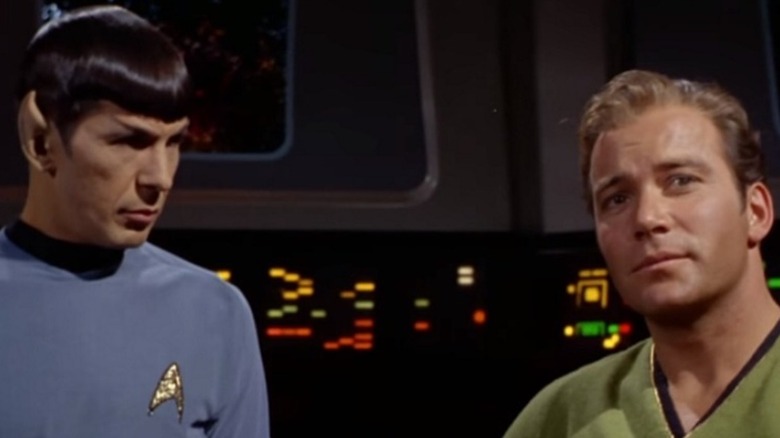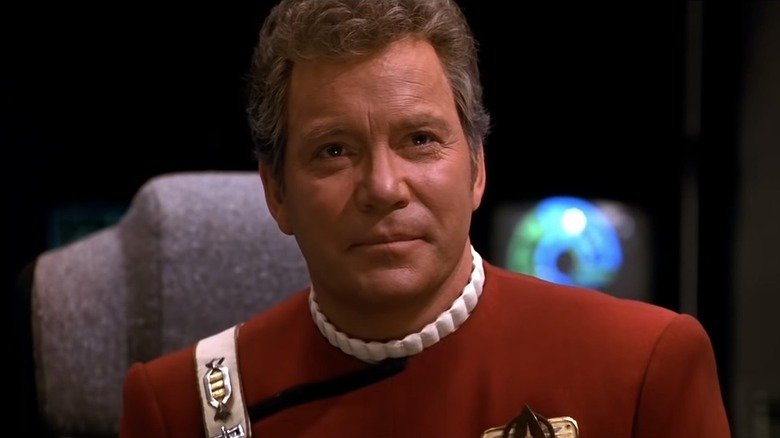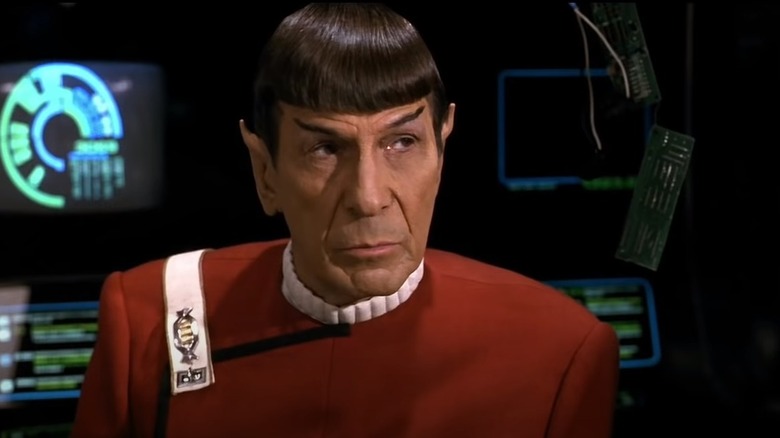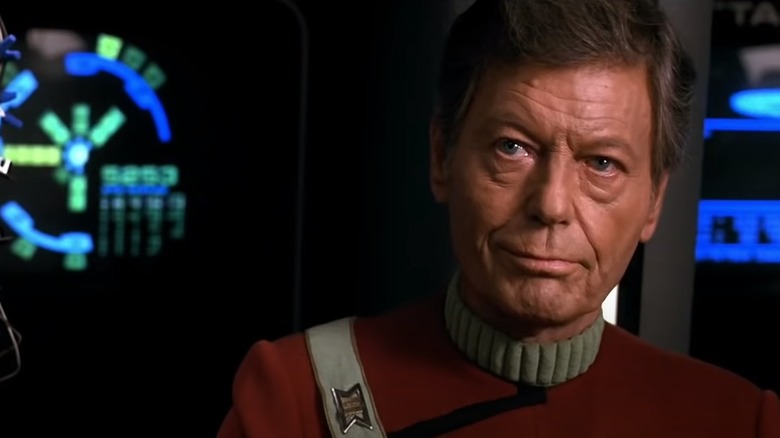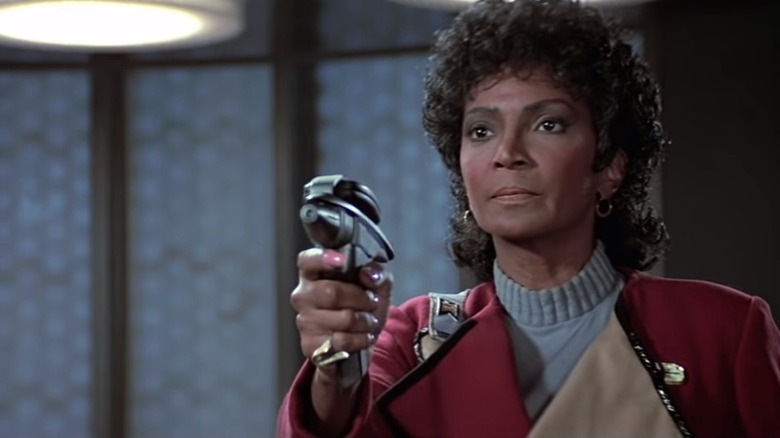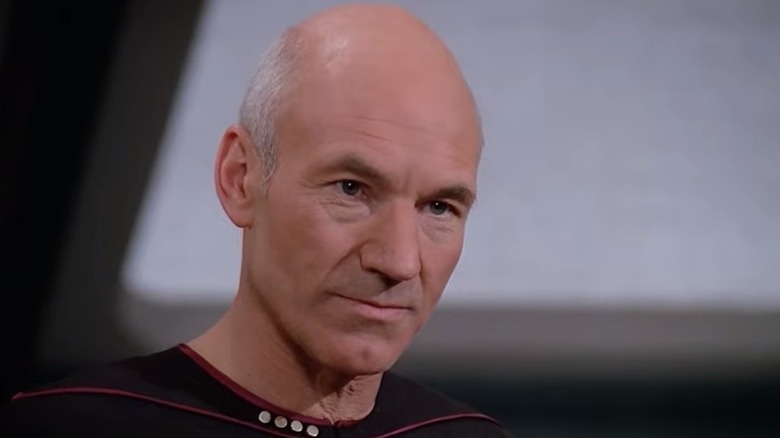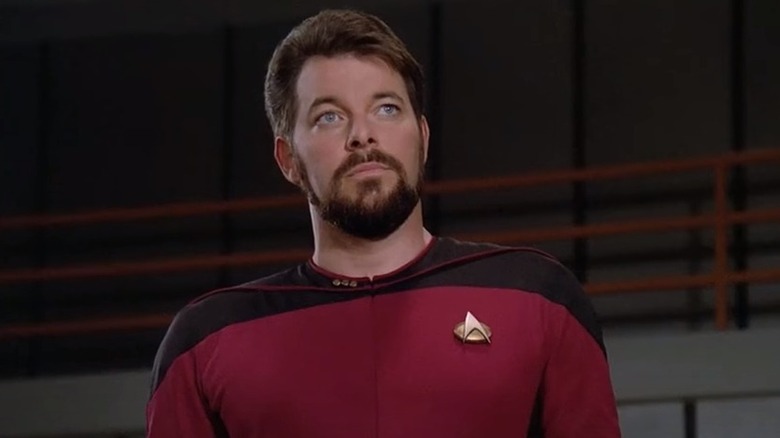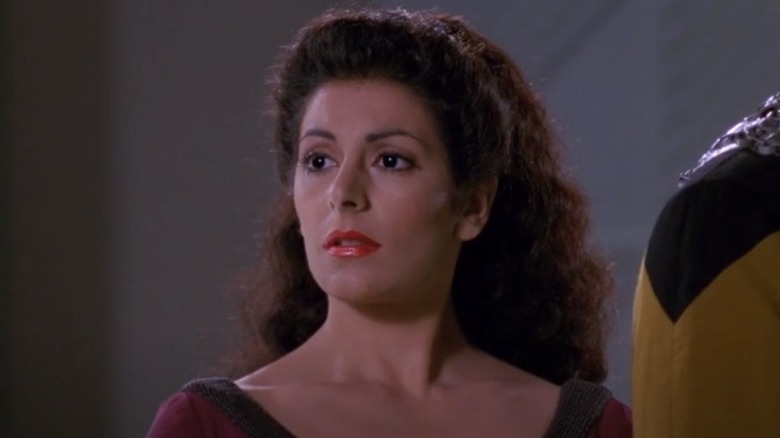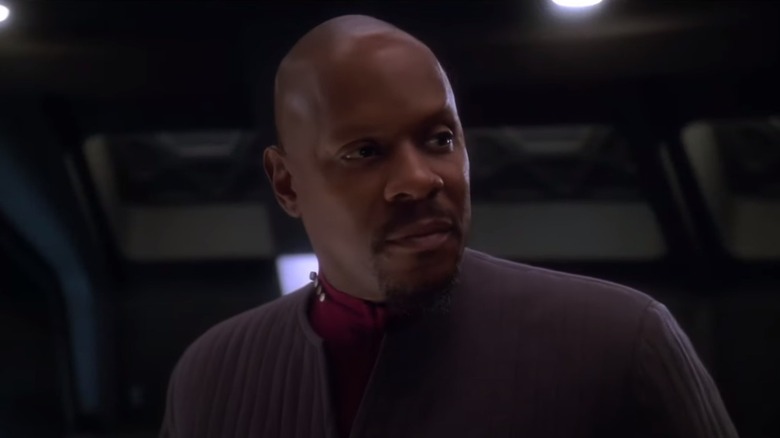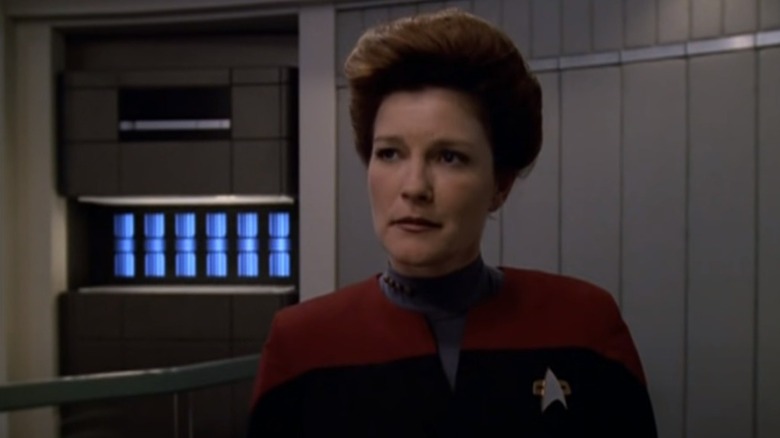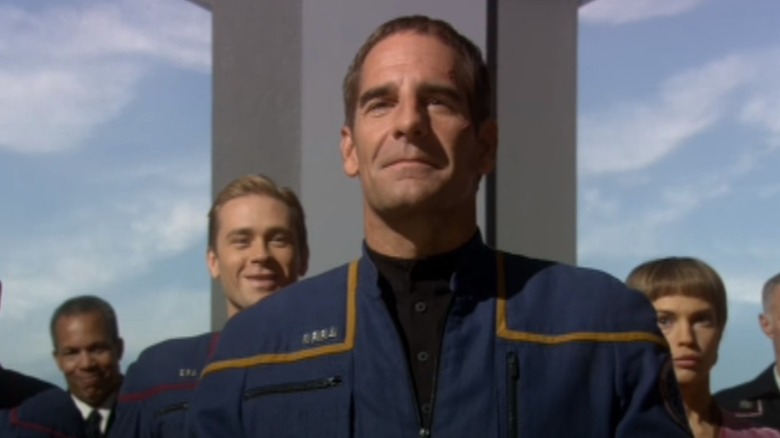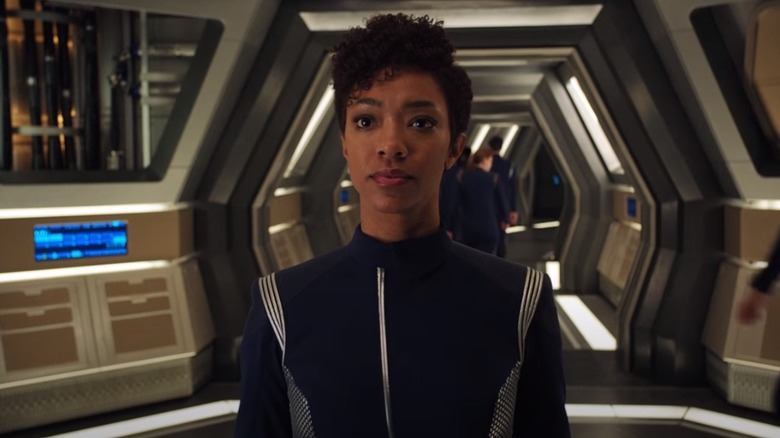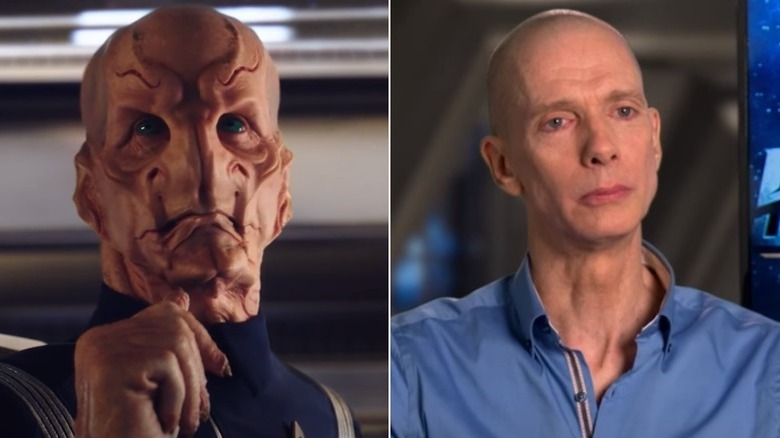Star Trek Actors Before They Made It Big
"Star Trek" is a pop culture phenomenon like no other. Although the original series ended in 1969 after just three seasons and 79 episodes, Gene Roddenberry's bold vision of the future has nonetheless lived on as a multimedia science fiction powerhouse spanning television, movies, comics, literature and games. Saved from obscurity by one of the most dedicated fandoms in history, "Star Trek" in its many iterations has been going strong for over five decades with new generations of fans and creators adding their own spin to Roddenberry's trailblazing adventure to the stars and beyond.
Unlike much of early TV sci-fi, "Star Trek" focused on complex, relatable characters and compelling, dramatic storylines, dropping the lasers and rockets formula of its Flash Gordon-inspired predecessors for action-infused allegory and often pointed social commentary. Although the crew of the Enterprise encountered countless hostile and benevolent alien races, the heart of "Star Trek's" storytelling was, and is, a reflection of the human condition and the promise of a better tomorrow.
"Star Trek" in its many forms has always relied on talented writers, directors, and a variety of behind the scenes creatives to bring Roddenberry's vision to the screen. However, it's the charismatic actors who populate "Star Trek's" worlds who have given the franchise's unique stories heart, soul, and life through their memorable performances. Many of them have taken journeys to fame that rival anything that the final frontier has to offer. Here are the amazing true stories of some of "Star Trek's" brightest stars.
William Shatner
William Shatner, best known as "Star Trek's" Captain James T. Kirk, was born March 22, 1931, in Montreal, Quebec, Canada, to Jewish immigrant parents, according to Biography. His mother, an elocution teacher, encouraged him to take up acting. As detailed in his autobiography, "Up Till Now," Shatner acted throughout his childhood in the Montreal Children's Theatre and on the radio show "Saturday Morning Fairy Tales."
Before pursuing acting professionally, Shatner earned a degree in commerce, which he put to use as an assistant theater manager. Soon after, he joined the National Repertory Theatre of Ottawa. After a stint on Broadway, Shatner began working in television. His first film role came in 1958 in "The Brothers Karamazov." In 1962, Shatner appeared in "The Intruder" as a charismatic racist who brings chaos to a small Southern town. Just prior to "Star Trek," Shatner starred in "The Incubus," a horror film shot entirely in the artificial language Esperanto.
Aside from his role as the beloved commanding officer of the U.S.S. Enterprise, Shatner's other claims to 1960s sci-fi fame were his two appearances on Rod Serling's "The Twilight Zone." In 1960's "Nick of Time," Shatner plays a newlywed who has a mysterious run-in with a fortune telling machine at a small town diner. However, Shatner's most celebrated "Twilight Zone" outing was "Nightmare at 20,000 Feet," which featured the actor as a nervous airline passenger who is the sole witness to a bizarre skyborne monster.
Leonard Nimoy
Leonard Nimoy, "Star Trek's" Mr. Spock, was born on March 26, 1931, in Boston's West End neighborhood. He grew up during the Great Depression in an apartment with his Russian-Jewish immigrant parents and grandparents.
Nimoy's first role was as Hansel in a production of "Hansel and Gretel" when he was 8. Despite his early aptitude for the stage, Nimoy wasn't immediately committed to an acting career. "I didn't have a clue," Nimoy said in an interview with the Television Academy Foundation. "I really didn't have a clue where I was going or what my intentions were until I was about 17. And then I got the call. . . I knew exactly what I wanted to do."
Stage roles and small parts on TV led to Nimoy's first movie role in 1951's "Queen for a Day," as reported in William Shatner's book "Leonard: My fifty-year friendship with a remarkable man." In 1953, Nimoy enlisted in the United States Army Reserve, where he put his talents to work writing, producing, directing, and narrating a variety of productions as a military entertainment specialist.
Following his discharge, Nimoy studied acting at the Pasadena Playhouse while working as a soda jerk, movie usher, and taxi driver to make ends meet. In the early 1960s, he became a regular face on TV appearing in such shows as "Wagon Train," "Perry Mason," and "The Twilight Zone," but, as documented in "Inside Star Trek" by Herbert Solow and Robert Justman, a small role on the TV drama "The Lieutenant" produced by Gene Roddenberry led directly to Nimoy being cast in "Star Trek."
DeForest Kelley
As reported by the Atlanta Journal Constitution, DeForest Kelley, "Star Trek's" irascible Dr. "Bones" McCoy, was born in either Toccoa or Atlanta, Georgia, on January 20, 1920. The son of a Baptist minister, young DeForest grew up in Conyers, Georgia, where he was active in his father's ministry. A major influence on Kelley's early life was his uncle, Dr. Luther Kelley who, according to the 2005 biography "From Sawdust to Stardust" by Terry Lee Rioux, had attended the future "Star Trek" actor's birth. Although it was Kelley's father's dream to see his son follow his brother into medicine, financial conditions during the Great Depression dashed his hopes.
Still, Kelley's parents recognized their son's talents as a singer and encouraged him to pursue music. Seeking to bring his son's gifts to a wider audience, Kelley's father brought him to the attention of Atlanta radio station WSB. Kelley's voice made him a regular on the station's broadcasts. Ultimately, Kelley would choose acting over music, leaving Georgia for California in the late 1930s.
Following his service in the U.S. Army Air Force during World War II, Kelley became a contract player for Paramount Pictures, according to StarTrek.com. Soon, Kelley became a fixture of TV and movie Westerns, in which he was regularly cast as a villain. Kelley's typecasting as a bad guy ended when he was cast as medical examiner Dr. Charlie Greene in the pilot for Gene Roddenberry's "Police Story," as detailed in "Inside Star Trek: The Real Story." The network passed on the show, but Roddenberry had found his Dr. McCoy.
Nichelle Nichols
Nichelle Nichols, who broke racial and gender barriers as "Star Trek's" Uhura, was born in Robbins, Illinois, just outside of Chicago on December 28, 1932, according to Blackpast. As detailed in her 1994 autobiography, "Beyond Uhura: Star Trek Memories and More," Nichols began dancing professionally at 14 in productions at Chicago's Sherman House Hotel. Soon after, she caught the eye of legendary band leader Duke Ellington, who was dazzled by both her dance skills and her singing voice. A few years later, Ellington hired Nichols as a dancer, choreographer, and singer in his touring show.
In 1951, Nichols' career as an entertainer briefly came to an end when she gave birth to her only child, Kyle. Abandoned by her husband, Nichols concentrated on motherhood and left show business to take a job as a file clerk. However, the stage was her true calling, and, after briefly considering a law career, Nichols was singing and dancing once again in a musical review titled "Calypso Carnival."
Prior to "Star Trek," Nichelle Nichols made her mark in the theater in west-coast productions of "The Roar of the Greasepaint–The Smell of the Crowd," ”For My People," and James Baldwin's "Blues for Mr. Charlie." In 1963, Nichols first met Gene Roddenberry when she was cast in a guest role on his military drama "The Lieutenant." While working on "The Lieutenant," she and Roddenberry, then still married to his first wife, began a romantic affair that ended sometime before "Star Trek" began.
Patrick Stewart
Sir Patrick Stewart, best known as "Star Trek: The Next Generation's" wise and diplomatic commanding officer Captain Jean-Luc Picard, was born on July 13, 1940, in the working class town of Mirfield in Yorkshire, England, according to "Patrick Stewart."
The actor grew up poor in a two-room house with his two older brothers and his parents. Stewart's mother, Gladys, worked in a cotton mill. His father, Alfred, had been a decorated soldier during World War II, but found transitioning to civilian life difficult. No longer commanding the respect of his peers as a military man, he took out his frustrations on his son.
Growing up in a home where violence was the norm made Stewart a schoolyard brawler who was quick to use his fists to settle any conflict. Fortunately, an English teacher set him on a path that would change his life. "He was the man who first put a copy of Shakespeare in my hands and said 'Read it out loud,' Stewart explained in the 2011 documentary "The Captains." At 15, Stewart left school to become a junior reporter for his hometown newspaper. When his dramatic pursuits began to interfere with his job, Stewart's boss gave him an ultimatum to choose journalism or acting. Stewart would go to join the renowned Royal Shakespeare Company, and, by the time he was cast as Picard, had already enjoyed a long career as one of England's leading stage actors.
Jonathan Frakes
Jonathan Frakes, who portrayed the Enterprise D's roguish first officer Commander Will Riker on "Star Trek: The Next Generation" and has since become an accomplished television and film director, was born August 19, 1952, in Bellefonte, Pennsylvania, according to "The Finest Crew in the Fleet: The Next Generation Cast On Screen and Off."
Although Frakes enjoyed performing in plays throughout junior high and high school, he didn't get serious about acting until college. While Frakes was working a summer job as an usher at the Festival of America Theatre, a director spotted him and suggested he would make a great addition to his play's chorus. Transformed by the experience, Frakes immediately changed his major from psychology to theater.
Upon graduating from Penn State with a BA in theatre arts, Frakes enrolled at Harvard, where he was active in the Loeb Drama Center. After receiving his master's degree, he moved to New York to seriously pursue a career on stage and screen. While waiting tables to make ends meet, Frakes took a job with Marvel Comics, traveling the country in costume as Captain America for comics conventions and special events, as reported by CBR. Following his short detour as a superhero, Frakes finally made it to Broadway with a role in the musical "Shenandoah," according to the TV Writer's Studio. Frakes then moved to TV with a role on the NBC soap "The Doctors," and took supporting roles in a number of popular shows throughout the 1970s and '80s including "The Waltons," "Fantasy Island," and "Quincey, M.E.," as explained by StarTrek.com.
Marina Sirtis
Marina Sirtis, born in London on March 29, 1959, grew up in a strict household where adherence to the family's Greek culture was paramount, according to "The Finest Crew in the Fleet: The Next Generation Cast On Screen and Off." Still, Sirtis developed a flair for performing early on, saying "My mother tells me that when I was three, I used to stand on the seat of the bus and sing to the other passengers. ...I would make my own little plays and climb up on a pile of rocks and sing—it was just something I always did. "
Against her parents wishes, Sirtis joined her high school's drama club with aspirations of pursuing an acting career. As a student at the Guildhall School of Drama, Sirtis made a memorable appearance as Ophelia in "Hamlet." However, a dispute with an instructor led to her leaving the school and joining the Worthington Repertory Theatre. While with Worthington, she toured as Magenta in "The Rocky Horror Show," according to Deseret News. A series of supporting roles in such films as "The Wicked Lady" and "Death Wish III," would lead Sirtis to move to Hollywood, where she would land the role of Counselor Deanna Troi on "Star Trek: The Next Generation" in 1987.
In 2019, Sirtis revealed that, as a child, she had been the victim of sexual assault committed by the son of a baby sitter (via NY Daily News). According to Sirtis, the trauma of the incident manifested as an eating disorder that she finally overcame with therapy.
Avery Brooks
Avery Brooks portrayed the imposing Captain Benjamin Sisko on "Star Trek: Deep Space Nine." According to StarTrek.com, he was born onOctober 2, 1948, in Evansville, Indiana and grew up in the industrial hub of Gary, Indiana. His mother, Eva, who worked as a music teacher and choral instructor, was one of the first African-American women to graduate with a master's degree in music from Illinois' Northwestern University. Like Eva Brooks, Avery made history with his academic achievements as the first African-American to earn an MFA in acting and directing at Rutgers University.
In college, Brooks' confidence was unshakeable. When his peers dismissed his chances of singing with Oberlin's renowned choir because of his background, he was determined to prove them wrong. "They laughed at me," Brooks says in "The Captains." "They said, 'You can't get in the choir. ... I'm from Gary, Indiana. I'm from this inner-city place. And so you can't get in. ... I just told them, 'I'm going in the morning and I'm going to get in the choir.'" Needless to say, Brooks made the cut.
In the 1980s, Brooks made his mark on TV co-starring alongside Robert Urich as on the ABC crime drama "Spenser for Hire." Brooks' streetwise character Hawk, proved so popular that the actor got his own spin-off series titled "A Man Called Hawk." Hawk made Brooks famous, however, he received the greatest accolades of his career for his performance in the musical "Paul Robeson," based on the life of the legendary singer.
Kate Mulgrew
As Captain (and later, Admiral) Kathryn Janeway on "Star Trek: Voyager" and the animated "Star Trek: Prodigy," Kate Mulgrew was the first woman to lead the cast of a "Star Trek" series, an honor she would hold from 1995 until the 2017 premiere of "Star Trek: Discovery" starring Sonequa Martin-Green, as reported by StarTrek.com.
According to TV Guide, Mulgrew was born on April 29, 1955, in Dubuque, Iowa, with a couple of unusual physical attributes: a set of teeth and a dangerous inability to feel pain. As Mulgrew relates in her 2015 memoir, "Born With Teeth," her prenatal chompers were quickly pulled to keep her from choking on them. To keep baby Kate from injuring herself, she was placed in a special crib. "They built me a little cage because I had no sense of pain until I was four years old," Mulgrew said in a 2016 interview. "So I was born with teeth and I had no sense of pain. Shakespeare would have had a field day. It's a witch!"
Mulgrew moved to New York at age 17 to study acting at New York University. While at NYU, she was accepted to the prestigious Stella Adler Conservatory, but dropped out in her junior year to act professionally. By 21, Mulgrew had appeared in the American Shakespeare Theatre's production of "Our Town" and had a regular role on the ABC soap opera "Ryan's Hope."
Scott Bakula
Scott Bakula was a sci-fi superstar long before he put on the uniform of Captain Jonathan Archer on "Star Trek: Enterprise." From 1989 to 1993, Bakula portrayed hapless time traveler Sam Beckett on NBC's "Quantum Leap." Although his journey as an actor led him to the final frontier, Bakula's path to the stars began on the Great White Way.
As detailed by StarTrek.com, Scott Bakula was born on October 9, 1954, in St. Louis Missouri. As a young man, Bakula planned to become a lawyer like his father. However, he was influenced by his parents' love of Broadway musicals to pursue singing and theatre. Early on, he established himself as a force in musical theatre with leading roles in such productions as "Godspell" and "Fiddler on the Roof."
SciFi.com reports that in 1976, Bakula moved to New York and made his Broadway debut as baseball legend Joe DiMaggio in "Marilyn: An American Fable." Just a year before Bakula was cast in "Quantum Leap," he was nominated for a Tony Award for his performance in the musical "Romance/Romance."
Sonequa Martin-Green
Sonequa Martin-Green currently stars as disgraced officer turned Star Fleet Captain Michael Burnham on Paramount+'s "Star Trek: Discovery." Like Scott Bakula, Martin-Green had already established herself in genre circles before being cast in the lead in a "Star Trek" series. Just prior to "Star Trek: Discovery," Martin-Greene played Sasha Williams in AMC's "The Walking Dead."
As detailed by Zora & Alice, Alabama native Martin-Greene was a dedicated student and her high school's salutatorian. Originally intent on pursuing a career as a psychologist, a role in a local play changed her life forever. StarTrek.com reports that Martin-Green studied theater at the University of Alabama, where she appeared on stage in many productions and was active in the honor society Alpha Psi Omega's Guerrilla Theatre group.
After graduating in 2007, Martin-Green made her way to New York where she began starring in small, independent films. She eventually made her way to Los Angeles where she was cast in supporting roles on such shows as "New Girl" and "Once Upon a Time."
Doug Jones
Although many fans may not recognize his face, Doug Jones, who plays "Star Trek: Discovery's" Kelpian Captain Saru, is one of the most prolific character actors in Hollywood. From the zombified Billy Butcherson from "Hocus Pocus" to "Hell Boy's" Abe Sapien to "The Shape of Water's" Amphibian Man, Jones has been a staple of science fiction, fantasy, and horror for decades (via StarTrek.com).
As detailed on his now defunct official website, Doug Jones was born on May 24, 1960 in Indianapolis. A trained mime and contortionist, Jones graduated from Ball State University in 1982. While at Ball State, Jones took on the first of what would be many costumed roles when he donned the feathers of Charlie Cardinal, BSU's beloved basketball mascot.
Jones' professional career began in 1987 in a series of McDonald's TV commercials (via Dread Central). In those ads, Jones portrayed the moon-headed lounge crooner Mac Tonight, who extolled the virtues of the fast food chain's dinner menu to the tune of Bobby Darin's "Mack the Knife."
